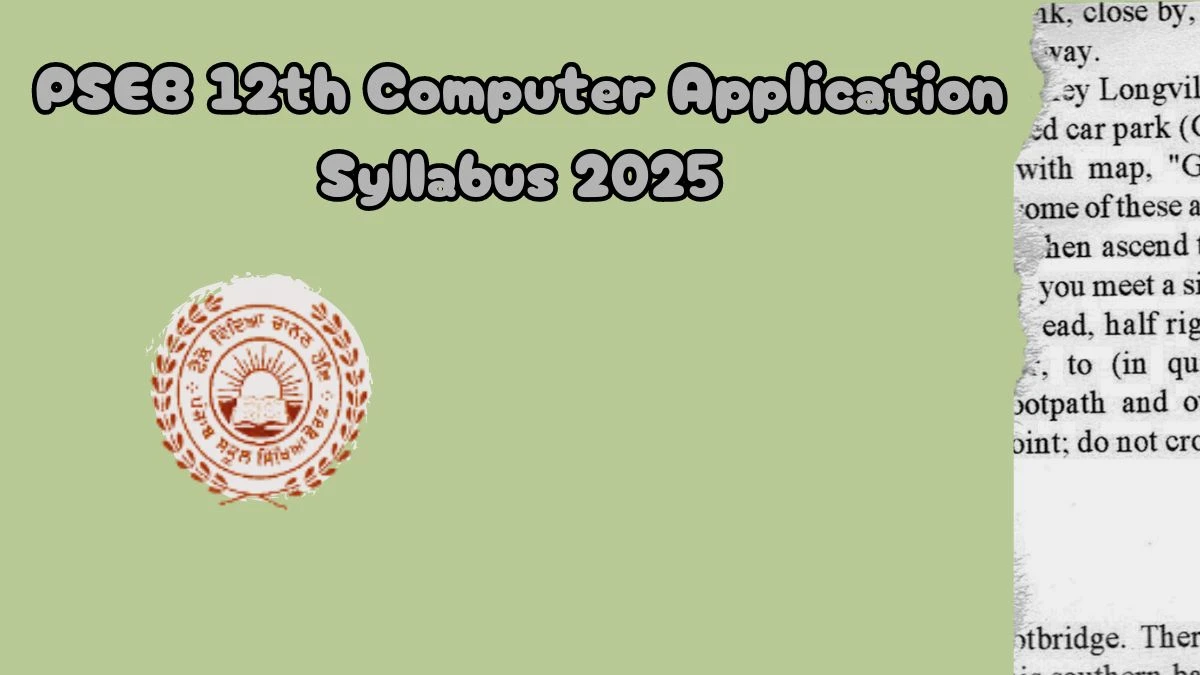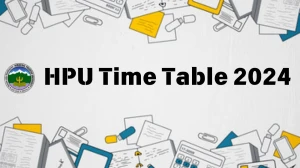- Rojgarlive »
- Education »
- PSEB 12th Computer Application Syllabus 2025 @ pseb.ac.in Check and Download Here
PSEB 12th Computer Application Syllabus 2025 @ pseb.ac.in Check and Download Here
by Keerthika
Updated May 17, 2024

PSEB 12th Computer Application Syllabus 2025 @ pseb.ac.in
The Punjab School Education Board, known as PSEB, has recently released the updated syllabus for the current academic session 2024-2025. The comprehensive syllabi for all Class 12 subjects are now available on the board's official website. Recognizing the challenge of finding authentic syllabi, we have provided subject-wise syllabus articles on our website for students' convenience. Here, we present the PSEB Class 12 Computer Application syllabus for 2024-25, along with a downloadable PDF link. Additionally, students can review the practical syllabus and the list of charts/models required for internal assessments.
Check - PSEB 12th Computer Application Syllabus 2025
Download Here - PSEB 12th Computer Application Syllabus 2025
Unit I: Networking and Internet:
• Introduction to Computer Networks: Network Concept, Types of
Networks (PAN, LAN, MAN, WAN), Networking Topologies (Bus,
Star, Ring, Tree, Mesh)
• Transmission Media: Guided (Wired) Communication Media
(Twisted pair cable, Co-axial cable, Fibre-optic cable), Un-Guided
(Wireless) Media (Radio waves, Micro waves, Infrared Waves)
• Network Devices: Modem, Network Interface Card (NIC), RJ45,
Repeater, Hub, Switch, Router, Gateway
• Network Protocol: HTTP, FTP, SMTP, TCP/IP, POP3, HTTPS, TELNET,
ARP, RDP, IMAP
• Internet Concepts: WWW, Domain Names, URL, Website, Web
Browser, Web Servers, Web Hosting, Concept of a Client and Server,
New Technologies such as Cloud and IoT
Unit II: Cyber Laws and Ethics:
• Cyber-Crime: Definition, Hacking, Spying (Eavesdropping), Phishing
and Fraud Emails, Ransomware, Preventing Cyber Crime
• Cyber Safety: Safely Browsing the Web, Identity Protection,
Confidentiality, Cyber Trolls and Bullying
• Safely Accessing Web Sites: Adware, Malware, Viruses, Trojans,
Phishing and Identity Verification
• CIA Triad
• Cyber Ethics
• E-Waste Management: Proper disposal of used Electronic Gadgets
• IT Act: Indian Information Technology Act (IT Act) 2000
Unit III: Database Management System
• Database concepts: Introduction to Data, Information, Database
and its needs, Traditional File System v/s Database System
• Data Models: Introduction, Hierarchical Data Model, Network Data
Model, Relational Data Model
• Introduction to DBMS: DBMS, Components of DBMS
• Relational Data Model: Relation, Attribute, Tuple, Domain, Degree,
Cardinality, Keys (Candidate Key, Primary Key, Alternate Key, Foreign
Key)
• Normalization: Anomalies in Unnormalized Database,
Dependencies, Normal Forms, 1NF, 2NF, 3NF
• MySQL: Introduction to MySQL, Data Types, Data Definition:
CREATE TABLE, DROP TABLE, ALTER TABLE; Data Query: SELECT,
FROM, WHERE; Data Manipulation: INSERT, UPDATE, DELETE; Using
Inbuilt Functions such as: Math functions, Text functions etc;
Querying and manipulating data using Group by, Having, Order by.
Unit IV: Software Engineering:
• Software and Software Engineering: Approach
• Software Development Life Cycle: SDLC and Its Phases
• Software Development Process Models: Waterfall, Prototyping
Unit V: Introduction to Python:
• Introduction to Python: Python and its features
• Setting up Python: System Requirements for Python, Downloading
and Installing Python, Intro to Python IDE, Executing a Simple "hello
world" Program
• Basic concepts for Python Programming: Python Character Set,
Python Tokens (Keyword, Identifier, Literal, Operator, Punctuator),
Variables, Concept of L-Value and R-Value, Use of Comments
Unit VI: Data Types, Operators and Expression in Python:
• Data Types: Number (Integer, Floating Point, Complex), Boolean,
Sequence (String, List, Tuple), None, Mapping (Dictionary), Mutable
and Immutable Data Types
• Operators: Arithmetic Operators, Relational Operators, Logical
Operators, Assignment Operator, Augmented Assignment Operators,
Identity Operators (is, is not), Membership Operators (in, not in)
• Expressions, Statement, Type Conversion & Input/Output:
Precedence of Operators, Expression, Evaluation of Expression,
Python Statement, Type Conversion (Explicit & Implicit Conversion),
Accepting Data as Input from the Console and Displaying Output
Unit VII: Control Statements in Python:
• Introduction: Use of Indentation, Sequential Flow, Conditional and
Iterative Flow control
• Conditional Statements: if, if-else, if-elif-else, Flowcharts, Simple
Programs: e.g.: absolute value, largest of 2 and 3 numbers, finding
divisibility of numbers etc
• Iterative Statements: for loop, Range Function, while loop,
Flowcharts, break and continue statements, nested loops, Suggested
Programs: Generating Pattern, Summation of series, Finding the
Factorial of a positive number etc
Unit VIII: Strings in Python:
• Introduction: Indexing, String Operations (Concatenation,
Repetition, Membership & Slicing)
• Built-In Functions: len(), capitalize(), title(), lower(), upper(), count(),
find(), index(), endswith(), startswith(), isalnum(), isalpha(), isdigit(),
islower(), isupper(), isspace(), lstrip(), rstrip(), strip(), replace(), join(),
partition(), split()
Unit IX: Lists, Tuples and Dictionaries in Python:
• Lists: Introduction, indexing, list operations (concatenation,
repetition, membership & slicing), traversing a list using loops, builtin functions: len(), list(), append(), extend(), insert(), count(), index(),
remove(), pop(), reverse(), sort(), sorted(), min(), max(), sum(); nested
lists
• Tuples: Introduction, indexing, tuple operations (concatenation,
repetition, membership & slicing), built-in functions: len(), tuple(),
count(), index(), sorted(), min(), max(), sum(); tuple assignment, nested
tuple
• Dictionary: Introduction, accessing items in a dictionary using keys,
mutability of dictionary (adding a new item, modifying an existing
item), traversing a dictionary, built-in functions: len(), dict(), keys(),
values(), items(), get(), update(), del(), clear(), fromkeys(), copy(), pop(),
popitem(), setdefault(), max(), min(), count(), sorted(), copy()
PSEB 12th Computer Application Syllabus 2025? -FAQ
Apart from the above, Commerce and Science students can choose Mathematics or Computer Application as additional subjects. PSEB 12th syllabus 2024 states that Arts students can opt for an additional from the subjects of their group.
| Exam Mode | Offline |
|---|---|
| Duration | 3 Hours |
| Type of Questions | Multiple Choice, Long/Short Questions |
| Subjects | Compulsory Subjects, Elective Subjects, Optional Subjects |
| Total Marks | 100 |




